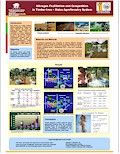| Poster |
 |
|
| Title | Nitrogen Facilitation and Competition in Timber tree - Maize Agroforestry System | | Author | Augustin R. Mercado Jr., Meine van Noordwijk, T Hilger and Georg Cadisch | | Year | 2008 | | Publisher | World Agroforestry Centre - ICRAF, SEA Regional Office | | City | Bogor, Indonesia | | Call Number | PO0145-08 | | Keywords | Nitrogen, competition, facilitation, Acacia mangium, Gmelina arborea |
|
| Abstract: |
| Crop yields are governed by nutrient facilitation and competition particularly nitrogen in simultaneous and sequential agroforestry systems. It was hypothesized that the N2-fixing Acacia mangium was less competitive for N during the intercrop phase and provided larger N benefits, particularly through belowground pathways, in the following crop phase than Gmelina arborea, a non N2-fixing tree. A half-drum experiment was conducted in Claveria, Misamis Oriental, Philippines to assess competition and understand below ground N dynamics using the above species in association with maize supplied with 0 or 80 N kg ha-1 (15N labelled) during 3 cropping cycles: 1 simultaneous and 2 sequential cycles. Tree plant parts were labelled using the 15N stem injection technique to quantify N transfer during the simultaneous phase, and to partition tree above and belowground biomass contribution to the subsequent maize crop. The N2 fixation of Acacia was determined using the 15N natural abundance method, and Gmelina was used as non-N2 fixing reference plant.
During the simultaneous phase, the proportion of N derived from N2 fixation by A. mangium was estimated at 42% and 69% with and without N application, respectively. The results of the 15N natural abundance method also indicated that the maize plants without N application obtained 15% of its N from A. mangium but only 3% when fertilized with N. Trees depressed associated maize growth parameters, except for grain yield when associated with A. mangium and supplied with N. G. arborea plant biomass responded strongly to the N application, but that of A. mangium did not. G. arborea had taken up 35% of the applied N, while A. mangium took up only 3% indicating that applied N was more available (sparing effect) for maize under A. mangium system than under G. arborea. Thus, N fertilizer use efficiency (FUE) in maize under A. mangium was 34% but only 16% under G. arborea. During the simultaneous phase, maize 15N recovery due to N transfer was 0.45% and 0.60% with A. mangium and G. arborea, respectively. More, finer, higher quality (low C:N ratio, low in polyphenols) roots of A. mangium that led to a larger and faster N turnover than G. arborea roots during the subsequent maize crop. Above-ground contributions by A. mangium were of less immediate benefit since due to the low quality leaf material that immobilized N. In contrast, G. arborea had higher quality leave residues that contributed to immediate net N mineralization.
The N2-fixing A. mangium produced more above - and belowground biomass, and had a faster root turnover, providing a better growing environment to associated maize crop during the simultaneous (sparing effect) and sequential (belowground contribution) phases than G. arborea. |
|